Managing Change within Organisations
VerifiedAdded on 2021/02/21
|13
|3726
|338
AI Summary
This assignment discusses the significance of implementing change within a business organisation to ensure its survival. It highlights the positive and negative impacts of change on the success and growth of a company. The responsibility lies with managers to take proper measures to minimize negative effects, and leaders should adopt supportive leadership styles to manage change effectively. Various studies and research papers are cited to demonstrate different approaches to leading change.
Contribute Materials
Your contribution can guide someone’s learning journey. Share your
documents today.
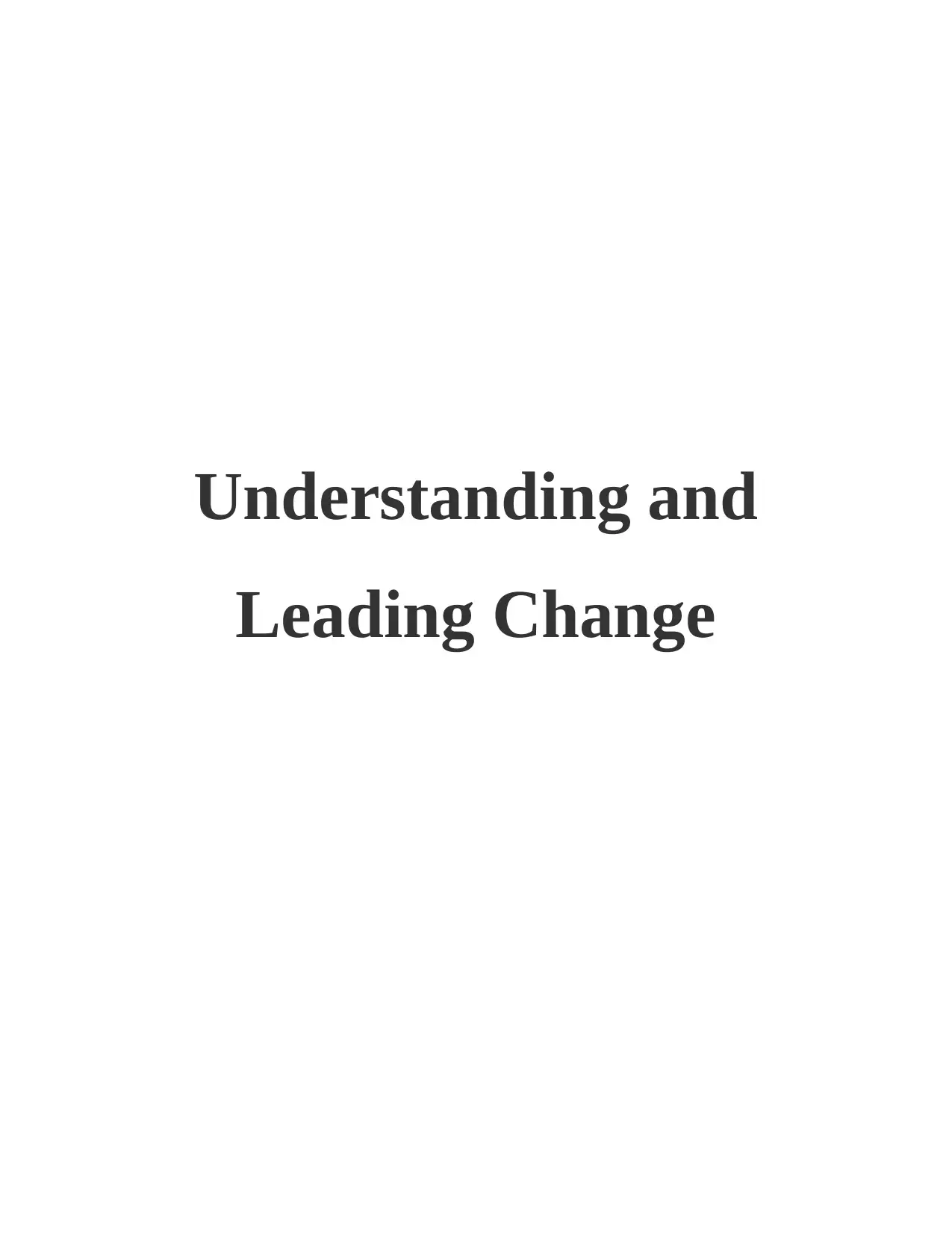
Understanding and
Leading Change
Leading Change
Secure Best Marks with AI Grader
Need help grading? Try our AI Grader for instant feedback on your assignments.
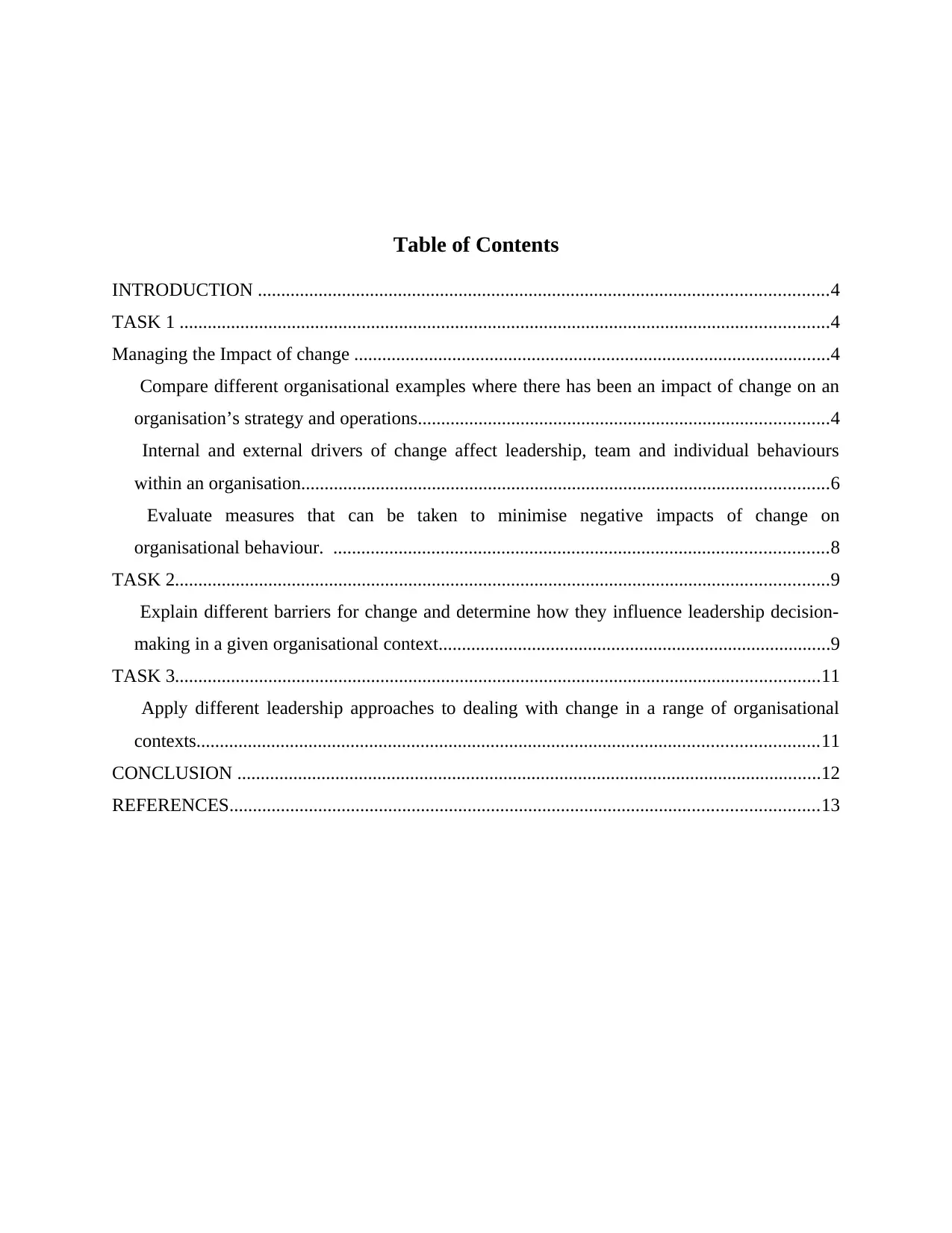
Table of Contents
INTRODUCTION ..........................................................................................................................4
TASK 1 ...........................................................................................................................................4
Managing the Impact of change ......................................................................................................4
Compare different organisational examples where there has been an impact of change on an
organisation’s strategy and operations........................................................................................4
Internal and external drivers of change affect leadership, team and individual behaviours
within an organisation.................................................................................................................6
Evaluate measures that can be taken to minimise negative impacts of change on
organisational behaviour. ..........................................................................................................8
TASK 2............................................................................................................................................9
Explain different barriers for change and determine how they influence leadership decision-
making in a given organisational context....................................................................................9
TASK 3..........................................................................................................................................11
Apply different leadership approaches to dealing with change in a range of organisational
contexts.....................................................................................................................................11
CONCLUSION .............................................................................................................................12
REFERENCES..............................................................................................................................13
INTRODUCTION ..........................................................................................................................4
TASK 1 ...........................................................................................................................................4
Managing the Impact of change ......................................................................................................4
Compare different organisational examples where there has been an impact of change on an
organisation’s strategy and operations........................................................................................4
Internal and external drivers of change affect leadership, team and individual behaviours
within an organisation.................................................................................................................6
Evaluate measures that can be taken to minimise negative impacts of change on
organisational behaviour. ..........................................................................................................8
TASK 2............................................................................................................................................9
Explain different barriers for change and determine how they influence leadership decision-
making in a given organisational context....................................................................................9
TASK 3..........................................................................................................................................11
Apply different leadership approaches to dealing with change in a range of organisational
contexts.....................................................................................................................................11
CONCLUSION .............................................................................................................................12
REFERENCES..............................................................................................................................13

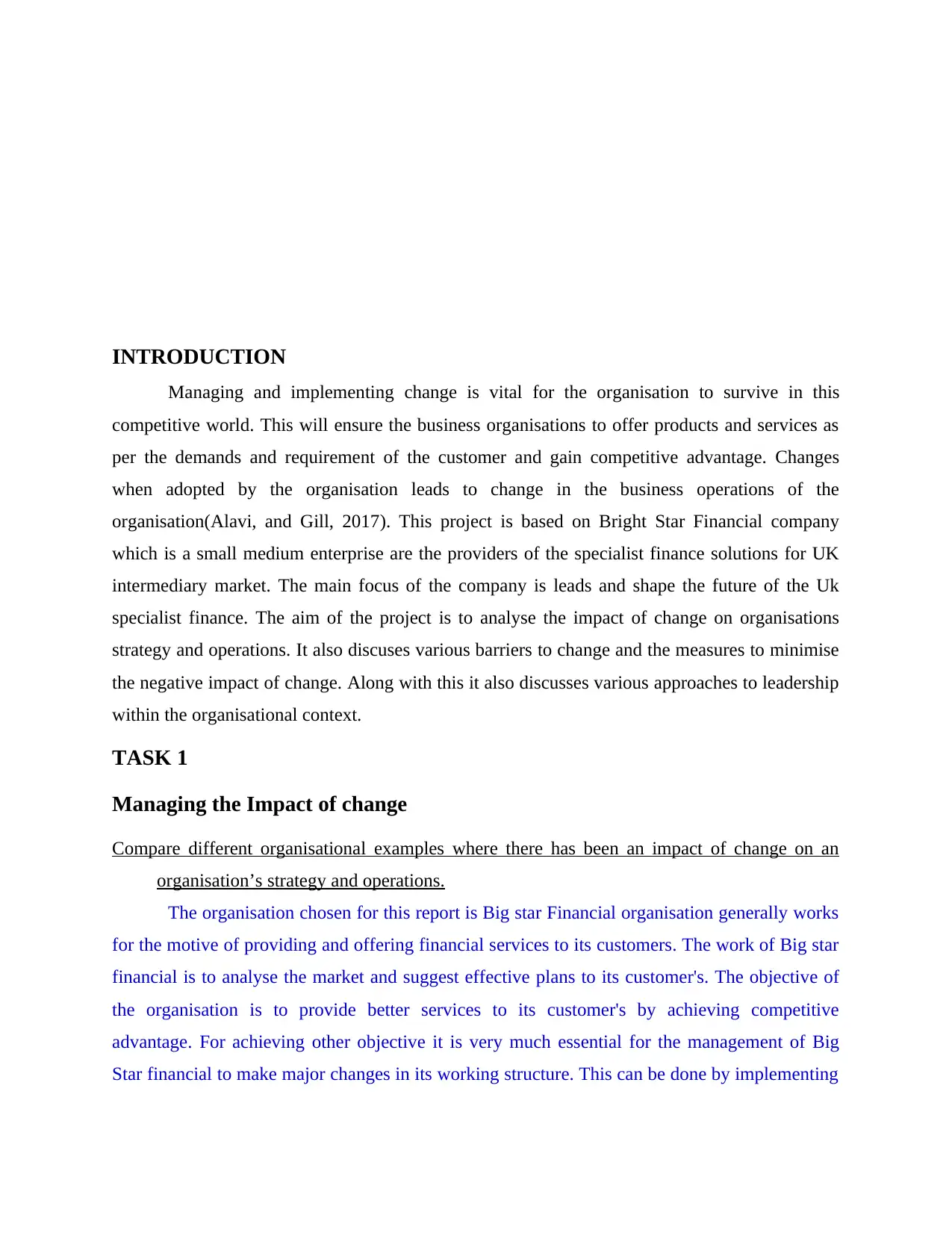
INTRODUCTION
Managing and implementing change is vital for the organisation to survive in this
competitive world. This will ensure the business organisations to offer products and services as
per the demands and requirement of the customer and gain competitive advantage. Changes
when adopted by the organisation leads to change in the business operations of the
organisation(Alavi, and Gill, 2017). This project is based on Bright Star Financial company
which is a small medium enterprise are the providers of the specialist finance solutions for UK
intermediary market. The main focus of the company is leads and shape the future of the Uk
specialist finance. The aim of the project is to analyse the impact of change on organisations
strategy and operations. It also discuses various barriers to change and the measures to minimise
the negative impact of change. Along with this it also discusses various approaches to leadership
within the organisational context.
TASK 1
Managing the Impact of change
Compare different organisational examples where there has been an impact of change on an
organisation’s strategy and operations.
The organisation chosen for this report is Big star Financial organisation generally works
for the motive of providing and offering financial services to its customers. The work of Big star
financial is to analyse the market and suggest effective plans to its customer's. The objective of
the organisation is to provide better services to its customer's by achieving competitive
advantage. For achieving other objective it is very much essential for the management of Big
Star financial to make major changes in its working structure. This can be done by implementing
Managing and implementing change is vital for the organisation to survive in this
competitive world. This will ensure the business organisations to offer products and services as
per the demands and requirement of the customer and gain competitive advantage. Changes
when adopted by the organisation leads to change in the business operations of the
organisation(Alavi, and Gill, 2017). This project is based on Bright Star Financial company
which is a small medium enterprise are the providers of the specialist finance solutions for UK
intermediary market. The main focus of the company is leads and shape the future of the Uk
specialist finance. The aim of the project is to analyse the impact of change on organisations
strategy and operations. It also discuses various barriers to change and the measures to minimise
the negative impact of change. Along with this it also discusses various approaches to leadership
within the organisational context.
TASK 1
Managing the Impact of change
Compare different organisational examples where there has been an impact of change on an
organisation’s strategy and operations.
The organisation chosen for this report is Big star Financial organisation generally works
for the motive of providing and offering financial services to its customers. The work of Big star
financial is to analyse the market and suggest effective plans to its customer's. The objective of
the organisation is to provide better services to its customer's by achieving competitive
advantage. For achieving other objective it is very much essential for the management of Big
Star financial to make major changes in its working structure. This can be done by implementing
Secure Best Marks with AI Grader
Need help grading? Try our AI Grader for instant feedback on your assignments.
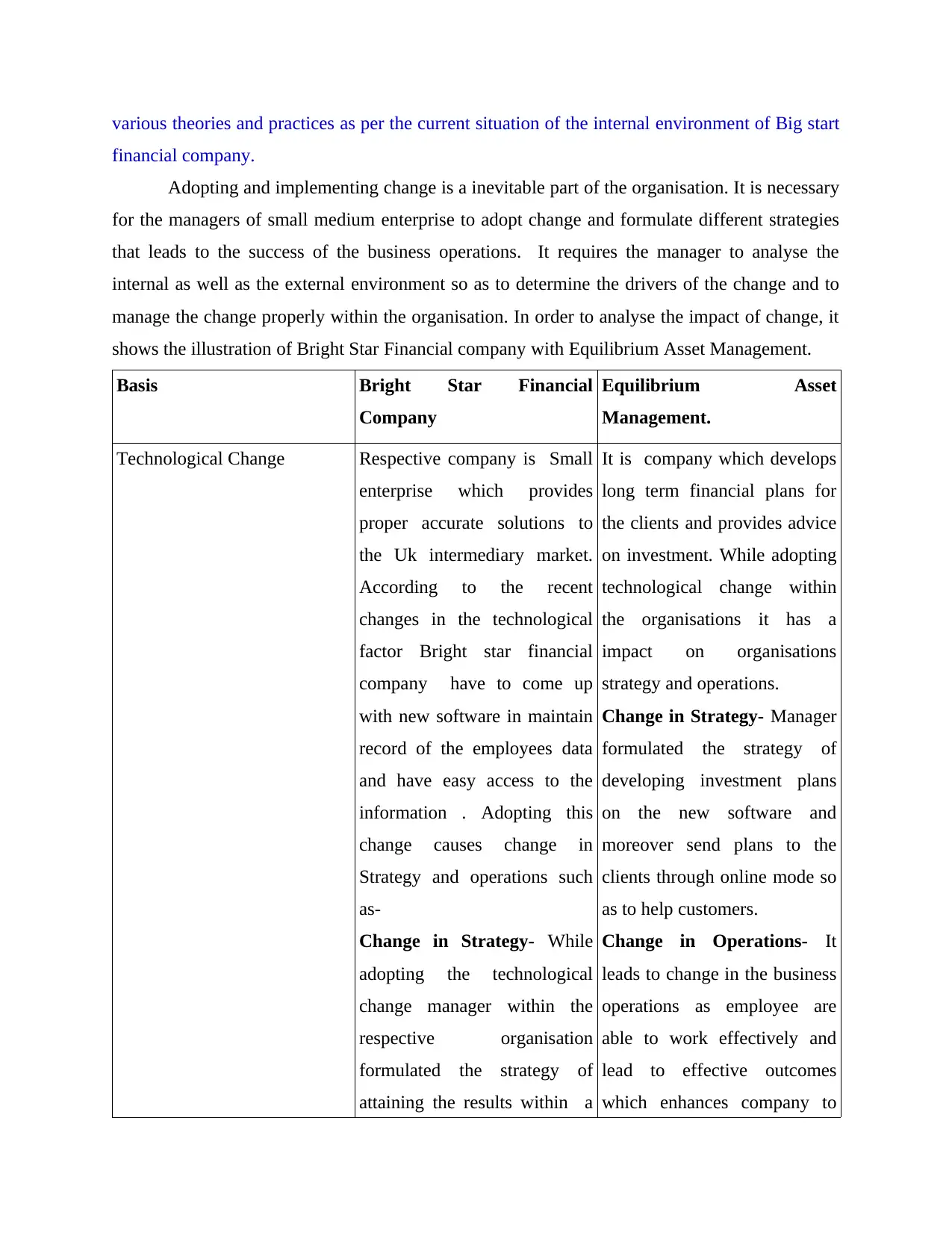
various theories and practices as per the current situation of the internal environment of Big start
financial company.
Adopting and implementing change is a inevitable part of the organisation. It is necessary
for the managers of small medium enterprise to adopt change and formulate different strategies
that leads to the success of the business operations. It requires the manager to analyse the
internal as well as the external environment so as to determine the drivers of the change and to
manage the change properly within the organisation. In order to analyse the impact of change, it
shows the illustration of Bright Star Financial company with Equilibrium Asset Management.
Basis Bright Star Financial
Company
Equilibrium Asset
Management.
Technological Change Respective company is Small
enterprise which provides
proper accurate solutions to
the Uk intermediary market.
According to the recent
changes in the technological
factor Bright star financial
company have to come up
with new software in maintain
record of the employees data
and have easy access to the
information . Adopting this
change causes change in
Strategy and operations such
as-
Change in Strategy- While
adopting the technological
change manager within the
respective organisation
formulated the strategy of
attaining the results within a
It is company which develops
long term financial plans for
the clients and provides advice
on investment. While adopting
technological change within
the organisations it has a
impact on organisations
strategy and operations.
Change in Strategy- Manager
formulated the strategy of
developing investment plans
on the new software and
moreover send plans to the
clients through online mode so
as to help customers.
Change in Operations- It
leads to change in the business
operations as employee are
able to work effectively and
lead to effective outcomes
which enhances company to
financial company.
Adopting and implementing change is a inevitable part of the organisation. It is necessary
for the managers of small medium enterprise to adopt change and formulate different strategies
that leads to the success of the business operations. It requires the manager to analyse the
internal as well as the external environment so as to determine the drivers of the change and to
manage the change properly within the organisation. In order to analyse the impact of change, it
shows the illustration of Bright Star Financial company with Equilibrium Asset Management.
Basis Bright Star Financial
Company
Equilibrium Asset
Management.
Technological Change Respective company is Small
enterprise which provides
proper accurate solutions to
the Uk intermediary market.
According to the recent
changes in the technological
factor Bright star financial
company have to come up
with new software in maintain
record of the employees data
and have easy access to the
information . Adopting this
change causes change in
Strategy and operations such
as-
Change in Strategy- While
adopting the technological
change manager within the
respective organisation
formulated the strategy of
attaining the results within a
It is company which develops
long term financial plans for
the clients and provides advice
on investment. While adopting
technological change within
the organisations it has a
impact on organisations
strategy and operations.
Change in Strategy- Manager
formulated the strategy of
developing investment plans
on the new software and
moreover send plans to the
clients through online mode so
as to help customers.
Change in Operations- It
leads to change in the business
operations as employee are
able to work effectively and
lead to effective outcomes
which enhances company to
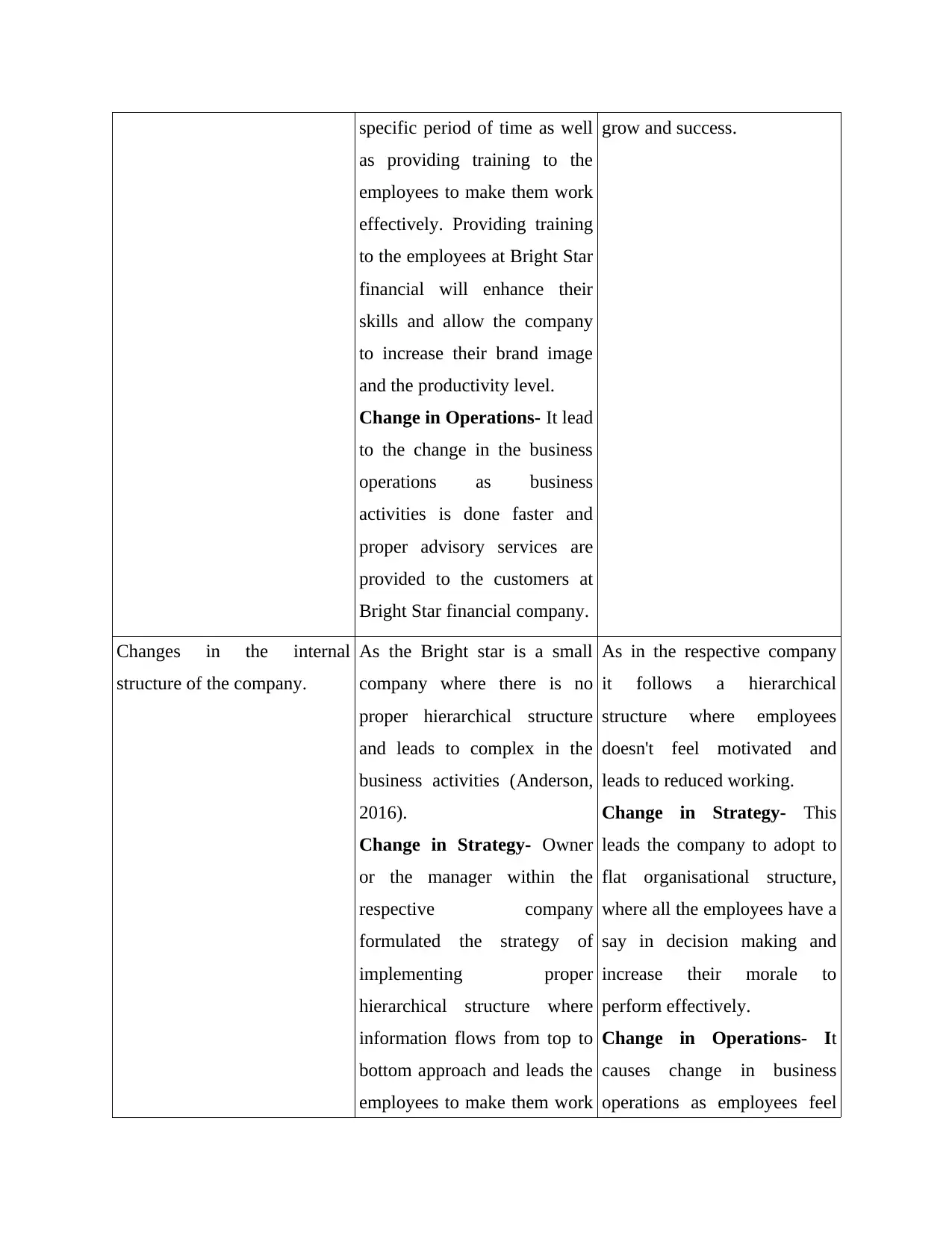
specific period of time as well
as providing training to the
employees to make them work
effectively. Providing training
to the employees at Bright Star
financial will enhance their
skills and allow the company
to increase their brand image
and the productivity level.
Change in Operations- It lead
to the change in the business
operations as business
activities is done faster and
proper advisory services are
provided to the customers at
Bright Star financial company.
grow and success.
Changes in the internal
structure of the company.
As the Bright star is a small
company where there is no
proper hierarchical structure
and leads to complex in the
business activities (Anderson,
2016).
Change in Strategy- Owner
or the manager within the
respective company
formulated the strategy of
implementing proper
hierarchical structure where
information flows from top to
bottom approach and leads the
employees to make them work
As in the respective company
it follows a hierarchical
structure where employees
doesn't feel motivated and
leads to reduced working.
Change in Strategy- This
leads the company to adopt to
flat organisational structure,
where all the employees have a
say in decision making and
increase their morale to
perform effectively.
Change in Operations- It
causes change in business
operations as employees feel
as providing training to the
employees to make them work
effectively. Providing training
to the employees at Bright Star
financial will enhance their
skills and allow the company
to increase their brand image
and the productivity level.
Change in Operations- It lead
to the change in the business
operations as business
activities is done faster and
proper advisory services are
provided to the customers at
Bright Star financial company.
grow and success.
Changes in the internal
structure of the company.
As the Bright star is a small
company where there is no
proper hierarchical structure
and leads to complex in the
business activities (Anderson,
2016).
Change in Strategy- Owner
or the manager within the
respective company
formulated the strategy of
implementing proper
hierarchical structure where
information flows from top to
bottom approach and leads the
employees to make them work
As in the respective company
it follows a hierarchical
structure where employees
doesn't feel motivated and
leads to reduced working.
Change in Strategy- This
leads the company to adopt to
flat organisational structure,
where all the employees have a
say in decision making and
increase their morale to
perform effectively.
Change in Operations- It
causes change in business
operations as employees feel
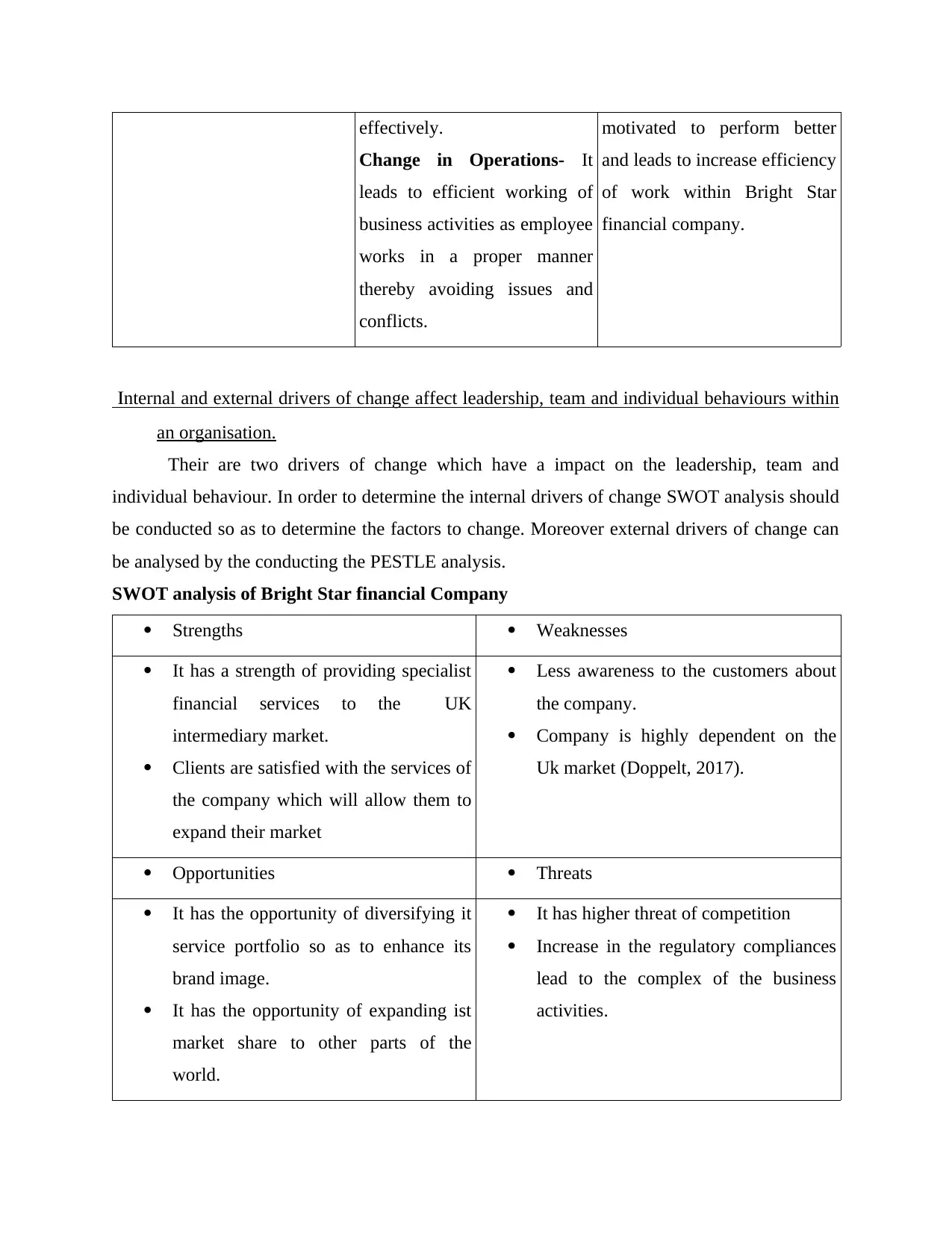
effectively.
Change in Operations- It
leads to efficient working of
business activities as employee
works in a proper manner
thereby avoiding issues and
conflicts.
motivated to perform better
and leads to increase efficiency
of work within Bright Star
financial company.
Internal and external drivers of change affect leadership, team and individual behaviours within
an organisation.
Their are two drivers of change which have a impact on the leadership, team and
individual behaviour. In order to determine the internal drivers of change SWOT analysis should
be conducted so as to determine the factors to change. Moreover external drivers of change can
be analysed by the conducting the PESTLE analysis.
SWOT analysis of Bright Star financial Company
Strengths Weaknesses
It has a strength of providing specialist
financial services to the UK
intermediary market.
Clients are satisfied with the services of
the company which will allow them to
expand their market
Less awareness to the customers about
the company.
Company is highly dependent on the
Uk market (Doppelt, 2017).
Opportunities Threats
It has the opportunity of diversifying it
service portfolio so as to enhance its
brand image.
It has the opportunity of expanding ist
market share to other parts of the
world.
It has higher threat of competition
Increase in the regulatory compliances
lead to the complex of the business
activities.
Change in Operations- It
leads to efficient working of
business activities as employee
works in a proper manner
thereby avoiding issues and
conflicts.
motivated to perform better
and leads to increase efficiency
of work within Bright Star
financial company.
Internal and external drivers of change affect leadership, team and individual behaviours within
an organisation.
Their are two drivers of change which have a impact on the leadership, team and
individual behaviour. In order to determine the internal drivers of change SWOT analysis should
be conducted so as to determine the factors to change. Moreover external drivers of change can
be analysed by the conducting the PESTLE analysis.
SWOT analysis of Bright Star financial Company
Strengths Weaknesses
It has a strength of providing specialist
financial services to the UK
intermediary market.
Clients are satisfied with the services of
the company which will allow them to
expand their market
Less awareness to the customers about
the company.
Company is highly dependent on the
Uk market (Doppelt, 2017).
Opportunities Threats
It has the opportunity of diversifying it
service portfolio so as to enhance its
brand image.
It has the opportunity of expanding ist
market share to other parts of the
world.
It has higher threat of competition
Increase in the regulatory compliances
lead to the complex of the business
activities.
Paraphrase This Document
Need a fresh take? Get an instant paraphrase of this document with our AI Paraphraser
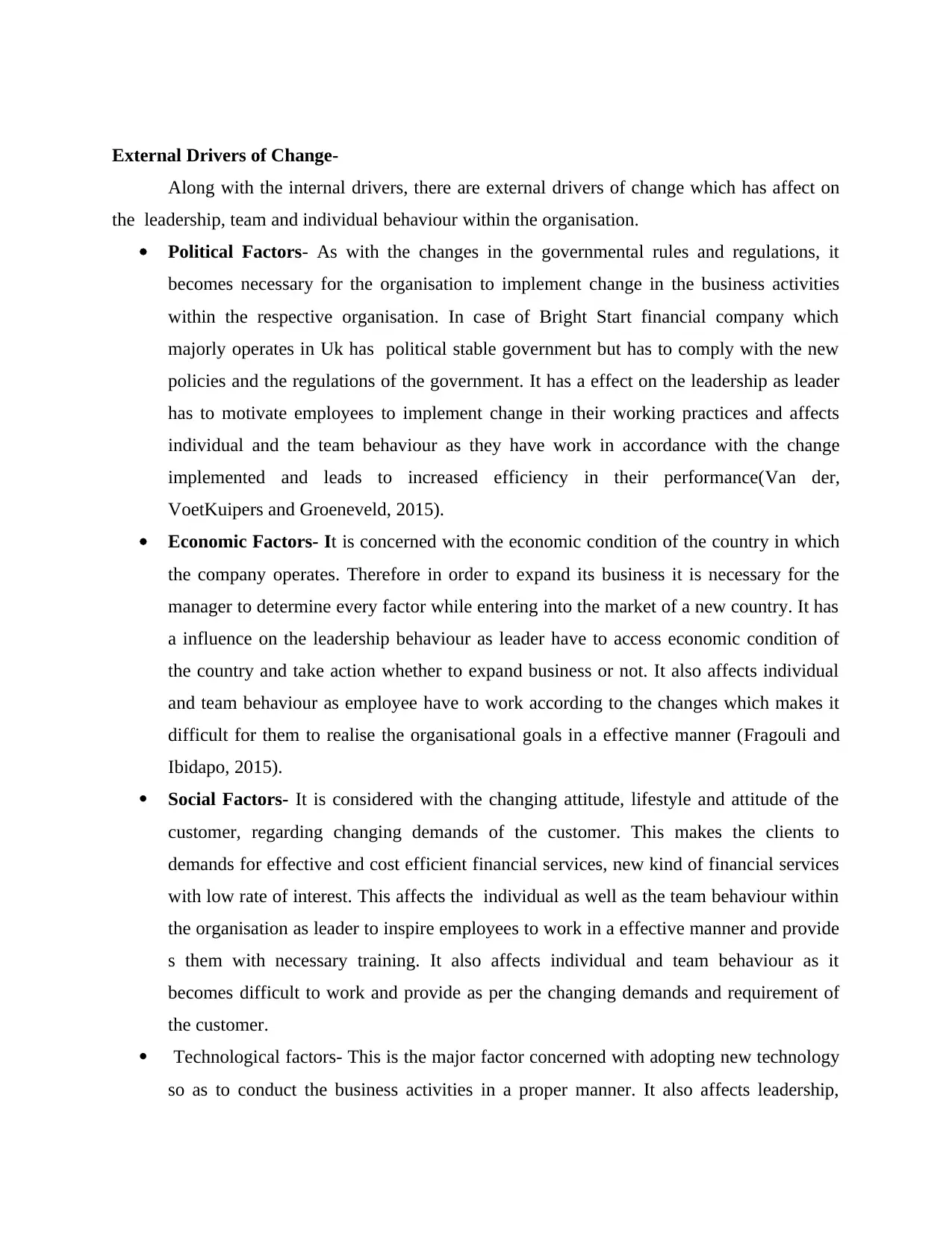
External Drivers of Change-
Along with the internal drivers, there are external drivers of change which has affect on
the leadership, team and individual behaviour within the organisation.
Political Factors- As with the changes in the governmental rules and regulations, it
becomes necessary for the organisation to implement change in the business activities
within the respective organisation. In case of Bright Start financial company which
majorly operates in Uk has political stable government but has to comply with the new
policies and the regulations of the government. It has a effect on the leadership as leader
has to motivate employees to implement change in their working practices and affects
individual and the team behaviour as they have work in accordance with the change
implemented and leads to increased efficiency in their performance(Van der,
VoetKuipers and Groeneveld, 2015).
Economic Factors- It is concerned with the economic condition of the country in which
the company operates. Therefore in order to expand its business it is necessary for the
manager to determine every factor while entering into the market of a new country. It has
a influence on the leadership behaviour as leader have to access economic condition of
the country and take action whether to expand business or not. It also affects individual
and team behaviour as employee have to work according to the changes which makes it
difficult for them to realise the organisational goals in a effective manner (Fragouli and
Ibidapo, 2015).
Social Factors- It is considered with the changing attitude, lifestyle and attitude of the
customer, regarding changing demands of the customer. This makes the clients to
demands for effective and cost efficient financial services, new kind of financial services
with low rate of interest. This affects the individual as well as the team behaviour within
the organisation as leader to inspire employees to work in a effective manner and provide
s them with necessary training. It also affects individual and team behaviour as it
becomes difficult to work and provide as per the changing demands and requirement of
the customer.
Technological factors- This is the major factor concerned with adopting new technology
so as to conduct the business activities in a proper manner. It also affects leadership,
Along with the internal drivers, there are external drivers of change which has affect on
the leadership, team and individual behaviour within the organisation.
Political Factors- As with the changes in the governmental rules and regulations, it
becomes necessary for the organisation to implement change in the business activities
within the respective organisation. In case of Bright Start financial company which
majorly operates in Uk has political stable government but has to comply with the new
policies and the regulations of the government. It has a effect on the leadership as leader
has to motivate employees to implement change in their working practices and affects
individual and the team behaviour as they have work in accordance with the change
implemented and leads to increased efficiency in their performance(Van der,
VoetKuipers and Groeneveld, 2015).
Economic Factors- It is concerned with the economic condition of the country in which
the company operates. Therefore in order to expand its business it is necessary for the
manager to determine every factor while entering into the market of a new country. It has
a influence on the leadership behaviour as leader have to access economic condition of
the country and take action whether to expand business or not. It also affects individual
and team behaviour as employee have to work according to the changes which makes it
difficult for them to realise the organisational goals in a effective manner (Fragouli and
Ibidapo, 2015).
Social Factors- It is considered with the changing attitude, lifestyle and attitude of the
customer, regarding changing demands of the customer. This makes the clients to
demands for effective and cost efficient financial services, new kind of financial services
with low rate of interest. This affects the individual as well as the team behaviour within
the organisation as leader to inspire employees to work in a effective manner and provide
s them with necessary training. It also affects individual and team behaviour as it
becomes difficult to work and provide as per the changing demands and requirement of
the customer.
Technological factors- This is the major factor concerned with adopting new technology
so as to conduct the business activities in a proper manner. It also affects leadership,
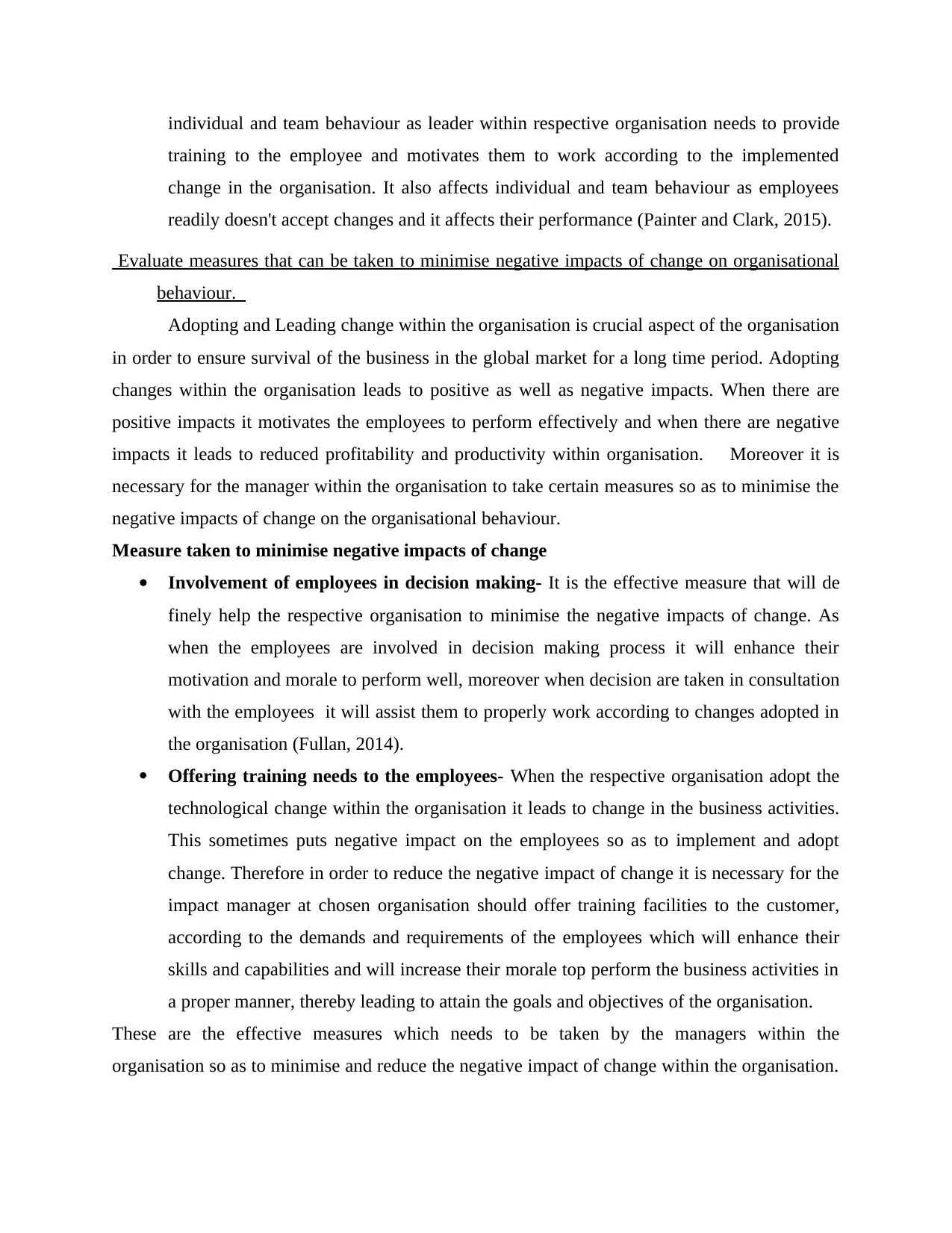
individual and team behaviour as leader within respective organisation needs to provide
training to the employee and motivates them to work according to the implemented
change in the organisation. It also affects individual and team behaviour as employees
readily doesn't accept changes and it affects their performance (Painter and Clark, 2015).
Evaluate measures that can be taken to minimise negative impacts of change on organisational
behaviour.
Adopting and Leading change within the organisation is crucial aspect of the organisation
in order to ensure survival of the business in the global market for a long time period. Adopting
changes within the organisation leads to positive as well as negative impacts. When there are
positive impacts it motivates the employees to perform effectively and when there are negative
impacts it leads to reduced profitability and productivity within organisation. Moreover it is
necessary for the manager within the organisation to take certain measures so as to minimise the
negative impacts of change on the organisational behaviour.
Measure taken to minimise negative impacts of change
Involvement of employees in decision making- It is the effective measure that will de
finely help the respective organisation to minimise the negative impacts of change. As
when the employees are involved in decision making process it will enhance their
motivation and morale to perform well, moreover when decision are taken in consultation
with the employees it will assist them to properly work according to changes adopted in
the organisation (Fullan, 2014).
Offering training needs to the employees- When the respective organisation adopt the
technological change within the organisation it leads to change in the business activities.
This sometimes puts negative impact on the employees so as to implement and adopt
change. Therefore in order to reduce the negative impact of change it is necessary for the
impact manager at chosen organisation should offer training facilities to the customer,
according to the demands and requirements of the employees which will enhance their
skills and capabilities and will increase their morale top perform the business activities in
a proper manner, thereby leading to attain the goals and objectives of the organisation.
These are the effective measures which needs to be taken by the managers within the
organisation so as to minimise and reduce the negative impact of change within the organisation.
training to the employee and motivates them to work according to the implemented
change in the organisation. It also affects individual and team behaviour as employees
readily doesn't accept changes and it affects their performance (Painter and Clark, 2015).
Evaluate measures that can be taken to minimise negative impacts of change on organisational
behaviour.
Adopting and Leading change within the organisation is crucial aspect of the organisation
in order to ensure survival of the business in the global market for a long time period. Adopting
changes within the organisation leads to positive as well as negative impacts. When there are
positive impacts it motivates the employees to perform effectively and when there are negative
impacts it leads to reduced profitability and productivity within organisation. Moreover it is
necessary for the manager within the organisation to take certain measures so as to minimise the
negative impacts of change on the organisational behaviour.
Measure taken to minimise negative impacts of change
Involvement of employees in decision making- It is the effective measure that will de
finely help the respective organisation to minimise the negative impacts of change. As
when the employees are involved in decision making process it will enhance their
motivation and morale to perform well, moreover when decision are taken in consultation
with the employees it will assist them to properly work according to changes adopted in
the organisation (Fullan, 2014).
Offering training needs to the employees- When the respective organisation adopt the
technological change within the organisation it leads to change in the business activities.
This sometimes puts negative impact on the employees so as to implement and adopt
change. Therefore in order to reduce the negative impact of change it is necessary for the
impact manager at chosen organisation should offer training facilities to the customer,
according to the demands and requirements of the employees which will enhance their
skills and capabilities and will increase their morale top perform the business activities in
a proper manner, thereby leading to attain the goals and objectives of the organisation.
These are the effective measures which needs to be taken by the managers within the
organisation so as to minimise and reduce the negative impact of change within the organisation.
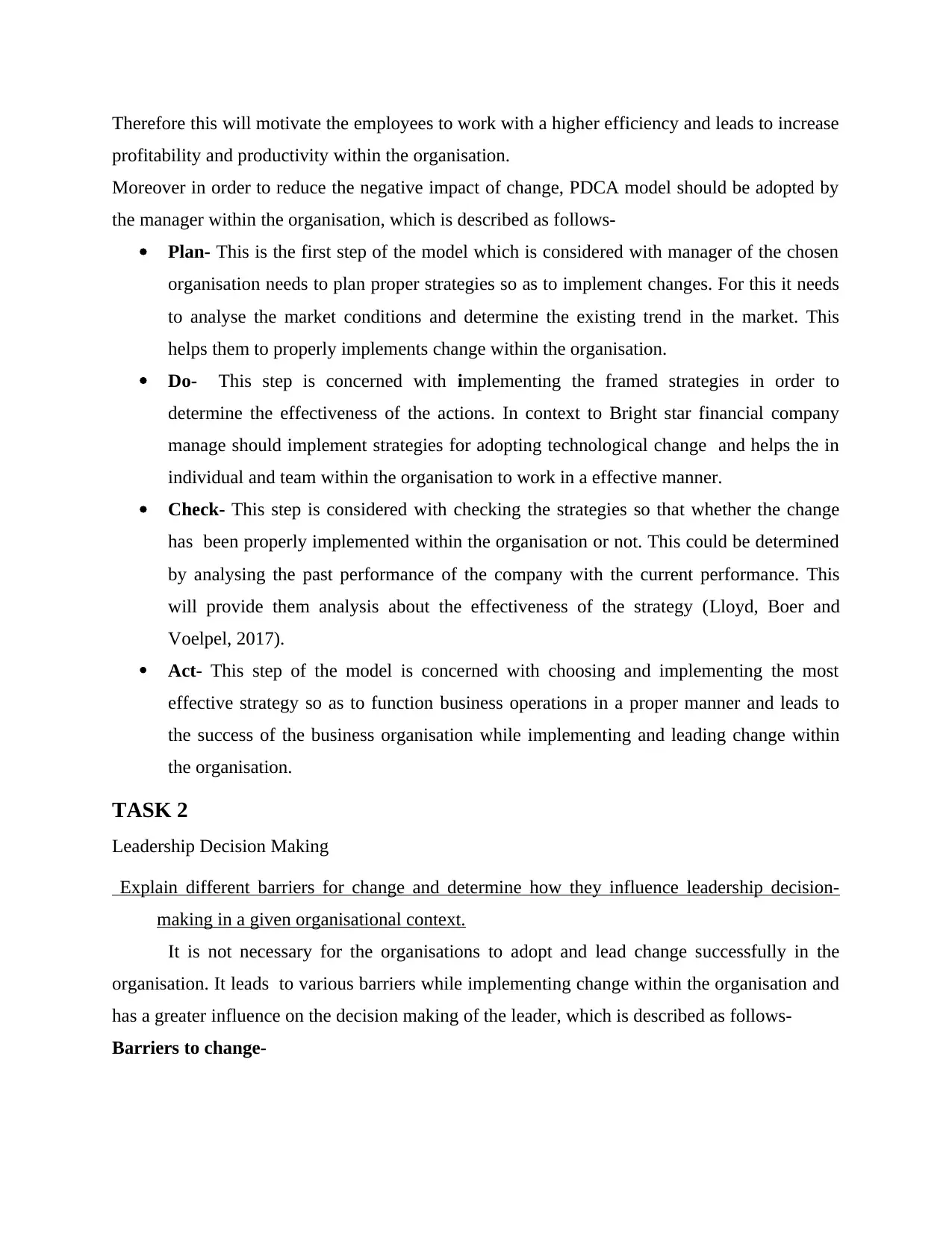
Therefore this will motivate the employees to work with a higher efficiency and leads to increase
profitability and productivity within the organisation.
Moreover in order to reduce the negative impact of change, PDCA model should be adopted by
the manager within the organisation, which is described as follows-
Plan- This is the first step of the model which is considered with manager of the chosen
organisation needs to plan proper strategies so as to implement changes. For this it needs
to analyse the market conditions and determine the existing trend in the market. This
helps them to properly implements change within the organisation.
Do- This step is concerned with implementing the framed strategies in order to
determine the effectiveness of the actions. In context to Bright star financial company
manage should implement strategies for adopting technological change and helps the in
individual and team within the organisation to work in a effective manner.
Check- This step is considered with checking the strategies so that whether the change
has been properly implemented within the organisation or not. This could be determined
by analysing the past performance of the company with the current performance. This
will provide them analysis about the effectiveness of the strategy (Lloyd, Boer and
Voelpel, 2017).
Act- This step of the model is concerned with choosing and implementing the most
effective strategy so as to function business operations in a proper manner and leads to
the success of the business organisation while implementing and leading change within
the organisation.
TASK 2
Leadership Decision Making
Explain different barriers for change and determine how they influence leadership decision-
making in a given organisational context.
It is not necessary for the organisations to adopt and lead change successfully in the
organisation. It leads to various barriers while implementing change within the organisation and
has a greater influence on the decision making of the leader, which is described as follows-
Barriers to change-
profitability and productivity within the organisation.
Moreover in order to reduce the negative impact of change, PDCA model should be adopted by
the manager within the organisation, which is described as follows-
Plan- This is the first step of the model which is considered with manager of the chosen
organisation needs to plan proper strategies so as to implement changes. For this it needs
to analyse the market conditions and determine the existing trend in the market. This
helps them to properly implements change within the organisation.
Do- This step is concerned with implementing the framed strategies in order to
determine the effectiveness of the actions. In context to Bright star financial company
manage should implement strategies for adopting technological change and helps the in
individual and team within the organisation to work in a effective manner.
Check- This step is considered with checking the strategies so that whether the change
has been properly implemented within the organisation or not. This could be determined
by analysing the past performance of the company with the current performance. This
will provide them analysis about the effectiveness of the strategy (Lloyd, Boer and
Voelpel, 2017).
Act- This step of the model is concerned with choosing and implementing the most
effective strategy so as to function business operations in a proper manner and leads to
the success of the business organisation while implementing and leading change within
the organisation.
TASK 2
Leadership Decision Making
Explain different barriers for change and determine how they influence leadership decision-
making in a given organisational context.
It is not necessary for the organisations to adopt and lead change successfully in the
organisation. It leads to various barriers while implementing change within the organisation and
has a greater influence on the decision making of the leader, which is described as follows-
Barriers to change-
Secure Best Marks with AI Grader
Need help grading? Try our AI Grader for instant feedback on your assignments.
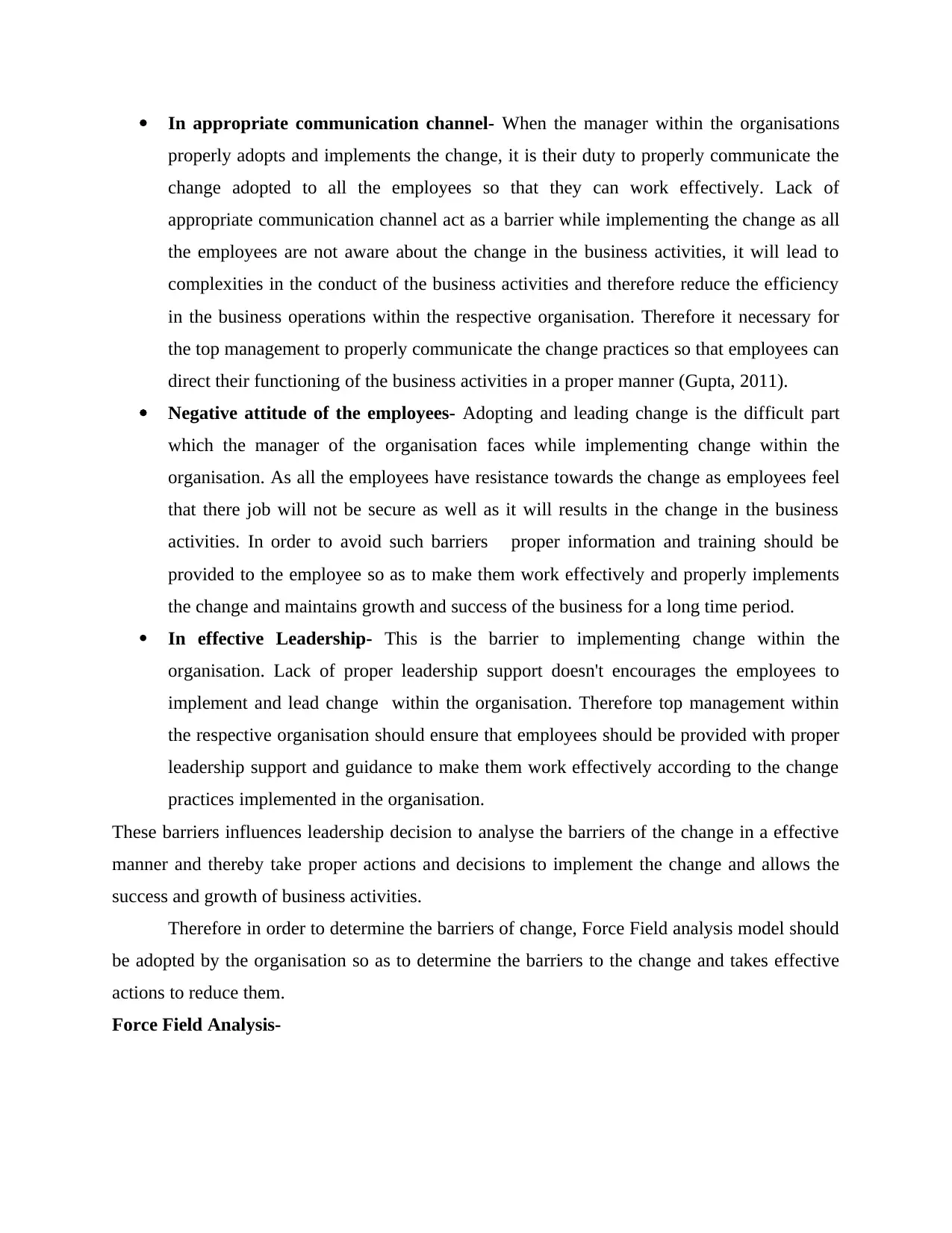
In appropriate communication channel- When the manager within the organisations
properly adopts and implements the change, it is their duty to properly communicate the
change adopted to all the employees so that they can work effectively. Lack of
appropriate communication channel act as a barrier while implementing the change as all
the employees are not aware about the change in the business activities, it will lead to
complexities in the conduct of the business activities and therefore reduce the efficiency
in the business operations within the respective organisation. Therefore it necessary for
the top management to properly communicate the change practices so that employees can
direct their functioning of the business activities in a proper manner (Gupta, 2011).
Negative attitude of the employees- Adopting and leading change is the difficult part
which the manager of the organisation faces while implementing change within the
organisation. As all the employees have resistance towards the change as employees feel
that there job will not be secure as well as it will results in the change in the business
activities. In order to avoid such barriers proper information and training should be
provided to the employee so as to make them work effectively and properly implements
the change and maintains growth and success of the business for a long time period.
In effective Leadership- This is the barrier to implementing change within the
organisation. Lack of proper leadership support doesn't encourages the employees to
implement and lead change within the organisation. Therefore top management within
the respective organisation should ensure that employees should be provided with proper
leadership support and guidance to make them work effectively according to the change
practices implemented in the organisation.
These barriers influences leadership decision to analyse the barriers of the change in a effective
manner and thereby take proper actions and decisions to implement the change and allows the
success and growth of business activities.
Therefore in order to determine the barriers of change, Force Field analysis model should
be adopted by the organisation so as to determine the barriers to the change and takes effective
actions to reduce them.
Force Field Analysis-
properly adopts and implements the change, it is their duty to properly communicate the
change adopted to all the employees so that they can work effectively. Lack of
appropriate communication channel act as a barrier while implementing the change as all
the employees are not aware about the change in the business activities, it will lead to
complexities in the conduct of the business activities and therefore reduce the efficiency
in the business operations within the respective organisation. Therefore it necessary for
the top management to properly communicate the change practices so that employees can
direct their functioning of the business activities in a proper manner (Gupta, 2011).
Negative attitude of the employees- Adopting and leading change is the difficult part
which the manager of the organisation faces while implementing change within the
organisation. As all the employees have resistance towards the change as employees feel
that there job will not be secure as well as it will results in the change in the business
activities. In order to avoid such barriers proper information and training should be
provided to the employee so as to make them work effectively and properly implements
the change and maintains growth and success of the business for a long time period.
In effective Leadership- This is the barrier to implementing change within the
organisation. Lack of proper leadership support doesn't encourages the employees to
implement and lead change within the organisation. Therefore top management within
the respective organisation should ensure that employees should be provided with proper
leadership support and guidance to make them work effectively according to the change
practices implemented in the organisation.
These barriers influences leadership decision to analyse the barriers of the change in a effective
manner and thereby take proper actions and decisions to implement the change and allows the
success and growth of business activities.
Therefore in order to determine the barriers of change, Force Field analysis model should
be adopted by the organisation so as to determine the barriers to the change and takes effective
actions to reduce them.
Force Field Analysis-
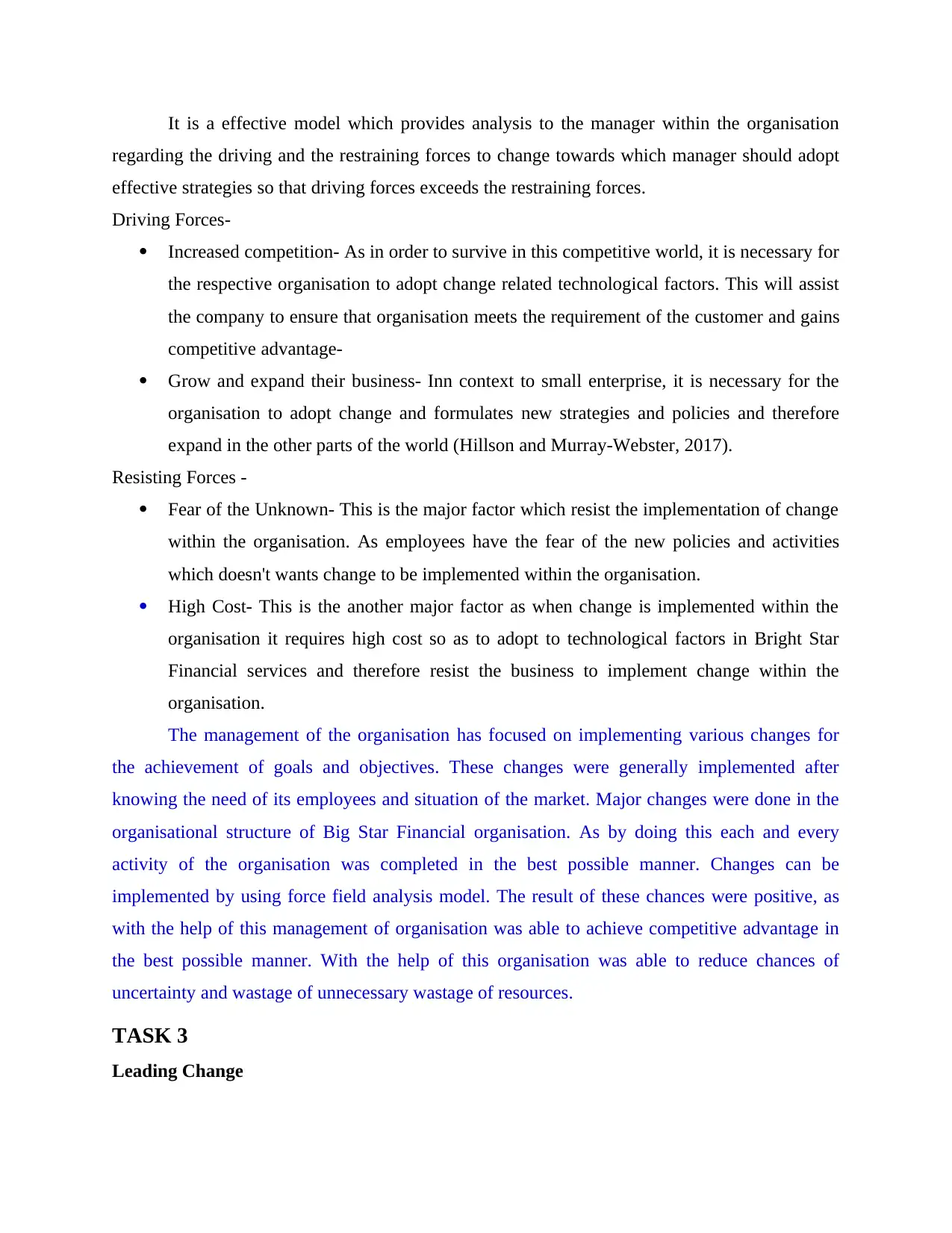
It is a effective model which provides analysis to the manager within the organisation
regarding the driving and the restraining forces to change towards which manager should adopt
effective strategies so that driving forces exceeds the restraining forces.
Driving Forces-
Increased competition- As in order to survive in this competitive world, it is necessary for
the respective organisation to adopt change related technological factors. This will assist
the company to ensure that organisation meets the requirement of the customer and gains
competitive advantage-
Grow and expand their business- Inn context to small enterprise, it is necessary for the
organisation to adopt change and formulates new strategies and policies and therefore
expand in the other parts of the world (Hillson and Murray-Webster, 2017).
Resisting Forces -
Fear of the Unknown- This is the major factor which resist the implementation of change
within the organisation. As employees have the fear of the new policies and activities
which doesn't wants change to be implemented within the organisation.
High Cost- This is the another major factor as when change is implemented within the
organisation it requires high cost so as to adopt to technological factors in Bright Star
Financial services and therefore resist the business to implement change within the
organisation.
The management of the organisation has focused on implementing various changes for
the achievement of goals and objectives. These changes were generally implemented after
knowing the need of its employees and situation of the market. Major changes were done in the
organisational structure of Big Star Financial organisation. As by doing this each and every
activity of the organisation was completed in the best possible manner. Changes can be
implemented by using force field analysis model. The result of these chances were positive, as
with the help of this management of organisation was able to achieve competitive advantage in
the best possible manner. With the help of this organisation was able to reduce chances of
uncertainty and wastage of unnecessary wastage of resources.
TASK 3
Leading Change
regarding the driving and the restraining forces to change towards which manager should adopt
effective strategies so that driving forces exceeds the restraining forces.
Driving Forces-
Increased competition- As in order to survive in this competitive world, it is necessary for
the respective organisation to adopt change related technological factors. This will assist
the company to ensure that organisation meets the requirement of the customer and gains
competitive advantage-
Grow and expand their business- Inn context to small enterprise, it is necessary for the
organisation to adopt change and formulates new strategies and policies and therefore
expand in the other parts of the world (Hillson and Murray-Webster, 2017).
Resisting Forces -
Fear of the Unknown- This is the major factor which resist the implementation of change
within the organisation. As employees have the fear of the new policies and activities
which doesn't wants change to be implemented within the organisation.
High Cost- This is the another major factor as when change is implemented within the
organisation it requires high cost so as to adopt to technological factors in Bright Star
Financial services and therefore resist the business to implement change within the
organisation.
The management of the organisation has focused on implementing various changes for
the achievement of goals and objectives. These changes were generally implemented after
knowing the need of its employees and situation of the market. Major changes were done in the
organisational structure of Big Star Financial organisation. As by doing this each and every
activity of the organisation was completed in the best possible manner. Changes can be
implemented by using force field analysis model. The result of these chances were positive, as
with the help of this management of organisation was able to achieve competitive advantage in
the best possible manner. With the help of this organisation was able to reduce chances of
uncertainty and wastage of unnecessary wastage of resources.
TASK 3
Leading Change
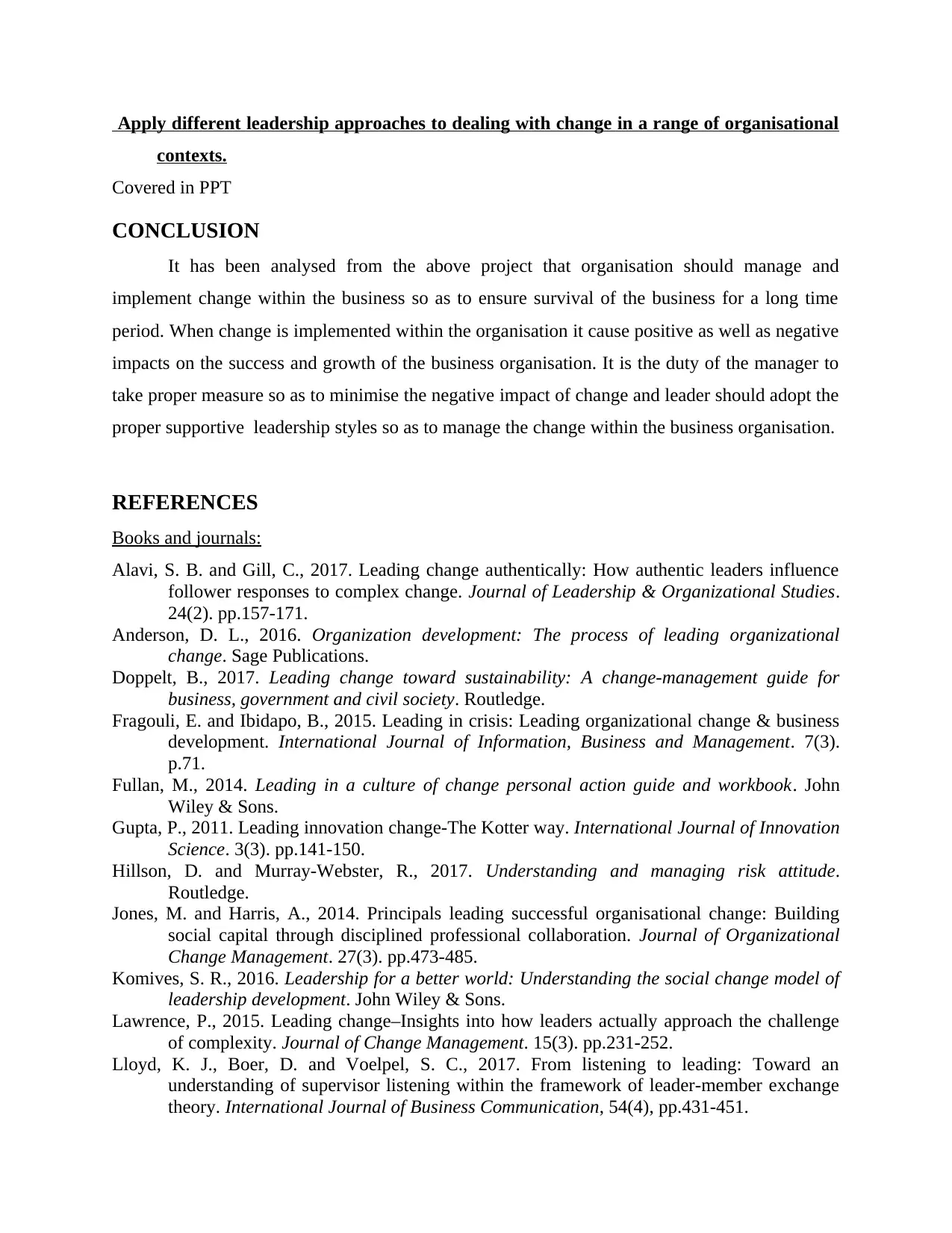
Apply different leadership approaches to dealing with change in a range of organisational
contexts.
Covered in PPT
CONCLUSION
It has been analysed from the above project that organisation should manage and
implement change within the business so as to ensure survival of the business for a long time
period. When change is implemented within the organisation it cause positive as well as negative
impacts on the success and growth of the business organisation. It is the duty of the manager to
take proper measure so as to minimise the negative impact of change and leader should adopt the
proper supportive leadership styles so as to manage the change within the business organisation.
REFERENCES
Books and journals:
Alavi, S. B. and Gill, C., 2017. Leading change authentically: How authentic leaders influence
follower responses to complex change. Journal of Leadership & Organizational Studies.
24(2). pp.157-171.
Anderson, D. L., 2016. Organization development: The process of leading organizational
change. Sage Publications.
Doppelt, B., 2017. Leading change toward sustainability: A change-management guide for
business, government and civil society. Routledge.
Fragouli, E. and Ibidapo, B., 2015. Leading in crisis: Leading organizational change & business
development. International Journal of Information, Business and Management. 7(3).
p.71.
Fullan, M., 2014. Leading in a culture of change personal action guide and workbook. John
Wiley & Sons.
Gupta, P., 2011. Leading innovation change-The Kotter way. International Journal of Innovation
Science. 3(3). pp.141-150.
Hillson, D. and Murray-Webster, R., 2017. Understanding and managing risk attitude.
Routledge.
Jones, M. and Harris, A., 2014. Principals leading successful organisational change: Building
social capital through disciplined professional collaboration. Journal of Organizational
Change Management. 27(3). pp.473-485.
Komives, S. R., 2016. Leadership for a better world: Understanding the social change model of
leadership development. John Wiley & Sons.
Lawrence, P., 2015. Leading change–Insights into how leaders actually approach the challenge
of complexity. Journal of Change Management. 15(3). pp.231-252.
Lloyd, K. J., Boer, D. and Voelpel, S. C., 2017. From listening to leading: Toward an
understanding of supervisor listening within the framework of leader-member exchange
theory. International Journal of Business Communication, 54(4), pp.431-451.
contexts.
Covered in PPT
CONCLUSION
It has been analysed from the above project that organisation should manage and
implement change within the business so as to ensure survival of the business for a long time
period. When change is implemented within the organisation it cause positive as well as negative
impacts on the success and growth of the business organisation. It is the duty of the manager to
take proper measure so as to minimise the negative impact of change and leader should adopt the
proper supportive leadership styles so as to manage the change within the business organisation.
REFERENCES
Books and journals:
Alavi, S. B. and Gill, C., 2017. Leading change authentically: How authentic leaders influence
follower responses to complex change. Journal of Leadership & Organizational Studies.
24(2). pp.157-171.
Anderson, D. L., 2016. Organization development: The process of leading organizational
change. Sage Publications.
Doppelt, B., 2017. Leading change toward sustainability: A change-management guide for
business, government and civil society. Routledge.
Fragouli, E. and Ibidapo, B., 2015. Leading in crisis: Leading organizational change & business
development. International Journal of Information, Business and Management. 7(3).
p.71.
Fullan, M., 2014. Leading in a culture of change personal action guide and workbook. John
Wiley & Sons.
Gupta, P., 2011. Leading innovation change-The Kotter way. International Journal of Innovation
Science. 3(3). pp.141-150.
Hillson, D. and Murray-Webster, R., 2017. Understanding and managing risk attitude.
Routledge.
Jones, M. and Harris, A., 2014. Principals leading successful organisational change: Building
social capital through disciplined professional collaboration. Journal of Organizational
Change Management. 27(3). pp.473-485.
Komives, S. R., 2016. Leadership for a better world: Understanding the social change model of
leadership development. John Wiley & Sons.
Lawrence, P., 2015. Leading change–Insights into how leaders actually approach the challenge
of complexity. Journal of Change Management. 15(3). pp.231-252.
Lloyd, K. J., Boer, D. and Voelpel, S. C., 2017. From listening to leading: Toward an
understanding of supervisor listening within the framework of leader-member exchange
theory. International Journal of Business Communication, 54(4), pp.431-451.
1 out of 13
Related Documents
Your All-in-One AI-Powered Toolkit for Academic Success.
+13062052269
info@desklib.com
Available 24*7 on WhatsApp / Email
![[object Object]](/_next/static/media/star-bottom.7253800d.svg)
Unlock your academic potential
© 2024 | Zucol Services PVT LTD | All rights reserved.





